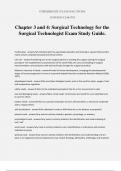©THEBRIGHT EXAM SOLUTIONS
11/05/2024 12:06 PM
Chapter 3 and 4: Surgical Technology for the
Surgical Technologist Exam Study Guide.
Professional - answer✔an individual who has specialized education and training in a given field and who
meets certain competency-based and ethical criteria
CST role - answer✔rendering care to the surgical patient in assisting the surgeon during the surgical
procedure- the establishment and protection of the sterile field, the care and handling of surgical
instrumentation, and assistance with technical tasks through the surgical procedure
Maslow's hierarchy of needs - answer✔model of human development, arranging the developmental
stages of human progression in term of a pyramid-shaped hierarchy created by Abraham Maslow (1968,
1971)
physiological needs - answer✔the most basic biological needs, such as the need for water, oxygen, food,
and temperature regulation
safety needs - answer✔refers to the individuals perception that his or her environment is safe
love and belonging needs - answer✔basic social needs: to be known and cared for as an individual and
to care for others
esteem needs - answer✔refers to a positive evaluation of one's self and others; a need to be respected
and to respect others
self-actualization - answer✔the individual's needs to fulfill what he or she believes is purposeful
physical need - answer✔any need or activity related to genetics, physiology, or anatomy
psychological need - answer✔any need or activity related to the identification and understanding of
one's self
social need - answer✔any need or activity related to one's identification or interaction with another
individual or group
spiritual need - answer✔any need or activity related to the identification and understanding of one's
place in an organized universe (expressions may involve theology, philosophy, mythology, and intuition)
, ©THEBRIGHT EXAM SOLUTIONS
11/05/2024 12:06 PM
common factors that result in surgical intervention - answer✔genetic malformation, trauma,
benign/malignant neoplasm, disease, condition, psychological state
adaptation and stress - answer✔The two broad factors that apply to the majority of patients and can be
further broken down into coping mechanisms are ___________________.
Roy Adaptation Model - answer✔developed by Sister Callista Roy; views the patient as a biopsychosocial
individual, constantly interacting with the environment with the ability to adapt by using coping skills in
dealing with internal and external stressors
Roy and Andrews, 2005 - answer✔interprets the environment as "all conditions, circumstances, and
influences that surround and affect the development and behavior of the person"
Roy and Anderson, 2005 - answer✔states that health involves becoming an integrated whole person
stress - answer✔defined by Dr. Hans Selye: "a nonspecific response of the body to a demand" that can
take the form of physical, chemical, or emotional phenomenon that causes tension
two types of stress - answer✔distress and eustress
distress - answer✔has negative implications
eustress - answer✔prefix eu means "well" or "good", is the term for the positive, desirable form of
stress (e.g., coming in first during a race, receiving a promotion, getting married, etc.)
coping mechanisms - answer✔denial, rationalization, regression, repression
denial - answer✔patient does not want to accept the truth of what is occuring
rationalization - answer✔patient attempts to rationalize illness or disease
regression - answer✔patient regresses to an earlier stage of life, such as adolescence, and exhibits
behaviors unique to that stage
repression - answer✔patient represses thoughts and feelings about illness or disease and does not want
to hold any discussions concerning what is happening
three stages of death - answer✔cardiac death, higher-brain death, whole-brain death
cardiac death - answer✔the irreversible loss of cardiac and respiratory function; this is the permanent
absence of heartbeat and respiration
higher-brain death - answer✔the irreversible loss of higher brain function; the brain stem continues to
provide respiration, blood pressure, and a heartbeat without the assistance of a respirator
whole-brain death - answer✔the irreversible loss of all functions of the entire brain; it includes a flat
EEG, unresponsiveness, lack of pupillary reflexes, and decreasing body temperature




